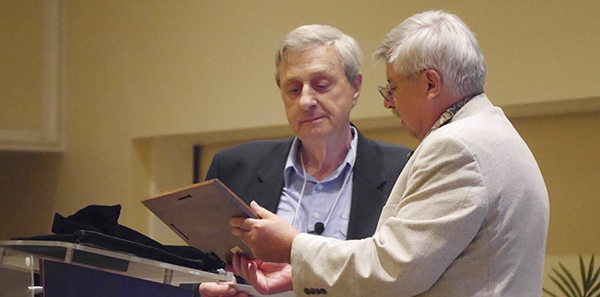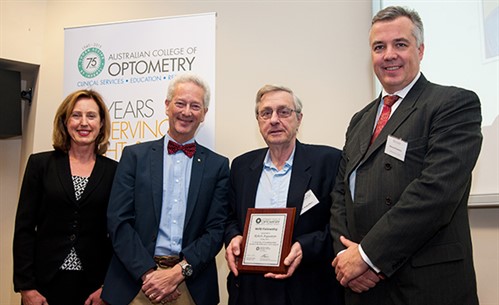1:30min

Professor Robert Augusteyn (L) receiving the Kinoshita Award from Peter Kador, secretary of The National Foundation for Eye Research Photo: Kanazawa Medical University
______________________________
By Helen Carter
Journalist
A life-time researching lens growth and the structure of the crystalline lens has led to many valuable discoveries by esteemed Melbourne biochemist Professor Robert Augusteyn.
For nearly five decades Professor Augusteyn has done the hard yards in the laboratory researching the topic, starting in 1969 and still going strong.
He recently received two prestigious accolades for his outstanding research and leadership.
In May, Professor Augusteyn received a National Vision Research Institute of Australia Fellowship from the Australian College of Optometry in recognition of his distinguished service to the NVRI and to vision research. He was the NVRI’s longest-serving director, having served 11 years in the role.
In December 2015, he received the most important prize in lens research worldwide, the Jin H Kinoshita Lecture Award, named after an eye research pioneer who ran the eye research section at America’s National Institutes of Health.
It is the most prestigious prize awarded by the National Foundation for Eye Research, and is given to researchers for meritorious research that contributes to the understanding of the aetiology and prevention of cataract development.
Professor Augusteyn travelled to Hawaii for the International Conference on The Lens to receive the plaque, US$15,000 prizemoney and lecture about his cataract and lens growth research.
He is a world authority on lens growth whose studies have not only helped uncover the mysteries of the lens but also leave a legacy of valuable basic research on lenses of humans and animals, and a vast legacy of knowledge about the crystalline lens. His research lays the foundation for future researchers to extend the work, hopefully leading to beneficial outcomes in eye diseases and vision disorders.
In 2014 The Group of Eight, Australia’s leading universities, released a policy note The Importance of Basic Research, stating: ‘The relationship between basic research and applied research is symbiotic in nature; both are necessary for the creation of breakthrough discoveries. The value of basic research goes beyond just the potential for commercial gain. It extends our curiosity and develops our understanding of human nature.’
Professor Augusteyn agrees that the information his basic research has uncovered is vital for other work.
Human lens different
He was the first to show that the human lens is different from lenses of all other species: mammals and other animals.
Other major achievements include his outstanding contributions to the chemistry of the crystalline lens and the nature of cataract.
Many of the known properties of a-crystallin are due to his work and he proposed the currently accepted model for its structure. He worked on the structure of proteins in the crystalline lens for three years at New York’s Columbia University Ophthalmology Department where he also became interested in cataract. He continued this work on his return to the University of Melbourne and while director of the National Vision Research Institute, worked on a mouse model which developed cataract.

Professor Augusteyn holding his NVRI Fellowship plaque with (L-R) Australian College of Optometry CEO Maureen O’Keefe, past president Professor Nathan Efron and president Professor Konrad Pesudovs Photo: ACO
Discoveries
On lenses
Some of his discoveries include:
* Human lens properties are different from those of other species, including other primates. The human lens grows in two phases and as a result, consists of two separate tissues, the nucleus and the cortex, while animal lenses have one single mode of growth and one tissue which is equivalent to the human lens nucleus. The nucleus is the functional part of the lens which determines focus. The human lens has a fast growth spurt prenatally, growing up to 150 mg by birth. This eventually becomes the adult nucleus after reshaping and compaction. A new growth process starts around this time and forms the cortex, a uniform layer around the nucleus. The cortex grows slowly during the rest of life up to about 300 mg by age 80-90 years. The human nucleus is the same as whole animal lenses in how it grows and in the types of proteins it produces but the cortex is the difference.
* At birth the human lens nucleus is close to spherical but it then flattens and by age 20 years is ellipsoid. The flattening is due entirely to changes in the nucleus of the lens. This shape change changes the optics.
* The lens grows by adding layers of cells at the outside, under the capsule, like layers on an onion. Since old cells are not discarded, the lens retains a record of its own growth. For research purposes, these layers can be peeled off a few at a time like an onion and the proteins in each layer can be studied in order to determine the effects of age, according to research by Professor Augusteyn and postgraduate student optometrist, now Professor, Barbara Pierscionek. In humans, researchers can peel off 20 layers to study from a 90-year-old lens while in a trevally (fish) aged about three years, they can peel 120 layers.
* Lens growth is continuous throughout life so you can determine the age of an animal by its lens weight. He showed this by studying 14,000 lenses from 130 species, many from his own laboratories. Professor Augusteyn developed a common equation to describe the lens growth of animals.
‘When I first presented my findings about differences in human and animal lenses at conferences and in journals, people didn’t believe it and some still don’t,’ he said.
* Characterising the various lens crystallins and determining their ontogenic development in human lenses.
* Professor Augusteyn and his colleagues showed that great care needs to be taken when handling and storing lenses since their properties can be altered, making it difficult to interpret results. When sheep eyes sit in liquid in a laboratory or storage for a few days they absorb water, an important finding for researchers as it can skew results if there is more water absorbed, making them heavier. In humans, fixative removes water from the human lens, another vital finding for researchers since fixed lenses are frequently used in experiments.
On cataract
Professor Augusteyn and his students showed that:
* Oxidation is the main factor in development of age-related cataract; free radicals from oxygen get into the lens and damage proteins.
* Hydrogen peroxide is probably responsible for senile nuclear cataract and the yellowing of the centre of the lens.
Professor Augusteyn is also a Professorial Visiting Fellow of UNSW Optometry and Vision Science, the first Voluntary Professor of Ophthalmology, University of Miami and past Senior Research Fellow Departments of Ophthalmology and Biochemistry, University of Melbourne and La Trobe University.
Gel implants for presbyopia
The value of his basic research is coming to the fore and moving to applied research in his current role at the Brien Holden Vision Institute, where he is working with researchers to develop a revolutionary implantable polymer gel for presbyopes to replace the crystalline lens of the eye which hardens naturally with age.
His data on how and why the lens grows and what it does are vital information for their work. He is contributing to the interpretation and design of experiments with researchers from the BHVI, the LV Prasad Eye Institute in India and the University of Miami.
They have been conducting in-depth studies on the optical and mechanical properties of the lens so they can surgically remove cell content of lenses and replace them with the polymer gel. His research will help determine how much gel to put in.
Bibliography and further reading references available on request to r.riches@optometry.org.au